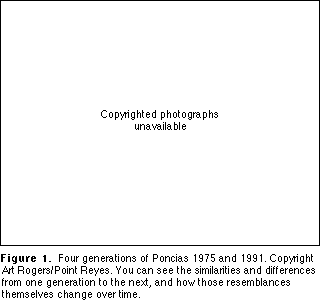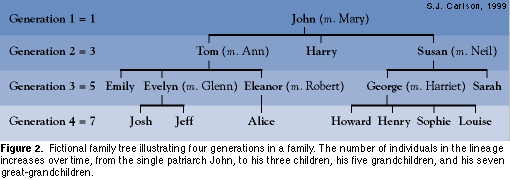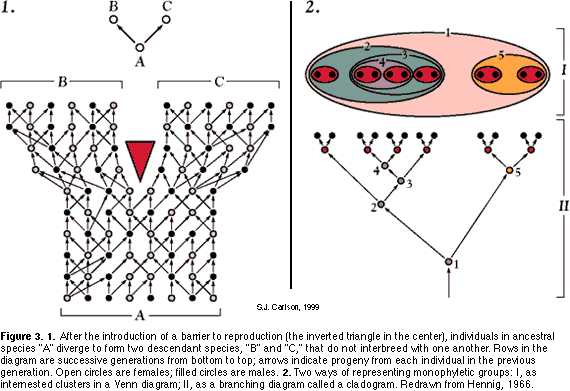Tracking the Course of Evolution
EVOLUTION AND SYSTEMATICS
From Evolution: Investigating the Evidence, Paleontological Society Special
Publication Volume 9, 1999. By permission of the Paleontological Society.
NOTE: This is page 1 of a five-page document.
INTRODUCTION
The biological process of evolution — descent with modification — generates and structures the remarkable diversity of life on Earth today and in the geological past. Take a moment to consider the vast number of different kinds of living things: mushrooms, koalas, sunflowers, whales, mosquitoes, kelp, bacteria, tapeworms, lichens, clams, redwoods, . . . The list could go on and on, seemingly forever. Without some understanding of how the diversity of life was generated, the scope of the diversity may seem overwhelming, perhaps even unknowable. Fortunately the structure of this extraordinary diversity, generated by the process of evolution, can be discovered using the methods of systematics. Evolution can be thought of as "an axiom from which systematic methods and concepts are deduced" (de Queiroz, 1988). Systematics, therefore, provides a way to organize the diversity surrounding us, and make sense of it in an evolutionary framework. Patterns of similarity and difference in morphology, genetics, and development — the evidence of evolution — can only be explained in an evolutionary context by means of systematics. No other method seeks to identify patterns that are evolutionary in origin, generated by the process of common descent.
 GENEALOGY AND DESCENT
GENEALOGY AND DESCENT
It is useful to study the process of descent with modification with reference to our own families. Each one of us has two biological parents, contributing an egg and a sperm, who together are responsible for our existence. Each one of our parents has parents, who themselves have parents, and so on back to the beginning of each family's history. In a very real sense, each generation in a family has given rise to the next generation by the process of descent. Each new generation shares many of its genetic and physical characteristics with the previous generation (Figure 1). This genetic continuity gives rise to family resemblances that may be passed on from generation to generation, making it easier to recognize members of the same family. How many of you have been told, "You look so much like your Uncle Robert (or Aunt Roberta)!"? Because humans are sexually reproducing organisms, genetic material is combined from two different individuals; thus the process of descent does not simply produce identical copies of individuals from one generation to the next. Not everyone in your family lineage looks exactly like every one else. Through reproduction with individuals in other families, each with a slightly different genetic make-up than your own family, the process of descent incorporates modification in shape and form, behavior, biochemistry, and other attributes. Resemblances generally fade as the number of generations between you and your ancestors increases. Chances are good that you resemble your parents more than your great, great-grandparents.
RETURN TO TOP
 If you are a Smith, consider your relationship to other Smiths in your home state, in North America, to the Smiths in other countries, back to the beginning of the Smith family hundreds of years ago. Just as you can trace back your own family history (Figure 2), we can extend this comparison far back in time to the origin of the "family" of human beings. All human beings (in the species Homo sapiens) are related to each other through a network of reproductive interactions that have occurred over many, many generations. In short, humans are one species. If you are a Smith, consider your relationship to other Smiths in your home state, in North America, to the Smiths in other countries, back to the beginning of the Smith family hundreds of years ago. Just as you can trace back your own family history (Figure 2), we can extend this comparison far back in time to the origin of the "family" of human beings. All human beings (in the species Homo sapiens) are related to each other through a network of reproductive interactions that have occurred over many, many generations. In short, humans are one species.

 Following the definition provided by Ernst Mayr in 1942, species are reproductive units — groups of interbreeding natural populations of organisms that are reproductively isolated from other such groups. Through time, a species may be thought of as a sequence of populations, breeding with each other, generation after generation (Figure 3.1). Members of the same species also tend to look and behave in similar ways. For paleontologists interested in understanding the genealogy of extinct creatures, this is an important characteristic of species — they not only form reproductive and genetic units, but also morphological units. We can most easily recognize members of the same species by the way they look and act; this is also how they can recognize themselves! Following the definition provided by Ernst Mayr in 1942, species are reproductive units — groups of interbreeding natural populations of organisms that are reproductively isolated from other such groups. Through time, a species may be thought of as a sequence of populations, breeding with each other, generation after generation (Figure 3.1). Members of the same species also tend to look and behave in similar ways. For paleontologists interested in understanding the genealogy of extinct creatures, this is an important characteristic of species — they not only form reproductive and genetic units, but also morphological units. We can most easily recognize members of the same species by the way they look and act; this is also how they can recognize themselves!
RETURN TO TOP

 Investigating the genealogical relationships among individuals within a single species, we can extend the comparison further and investigate the phylogenetic relationships among species in a more inclusive group related by common ancestry. For example, the group of primates that humans are most closely related to, falls within the more inclusive group of mammals, and the yet more inclusive group of vertebrates, and so on. Each one of us is a member of a nearly infinite number of more and more inclusive groups, nested one within another, delineated by the process of descent with modification. Investigating the genealogical relationships among individuals within a single species, we can extend the comparison further and investigate the phylogenetic relationships among species in a more inclusive group related by common ancestry. For example, the group of primates that humans are most closely related to, falls within the more inclusive group of mammals, and the yet more inclusive group of vertebrates, and so on. Each one of us is a member of a nearly infinite number of more and more inclusive groups, nested one within another, delineated by the process of descent with modification.
RETURN TO TOP
 All organisms are related to one another, more or less distantly, through the process of evolution. This is not an insignificant statement. Human beings and carrots would seem to have little in common. Yet both share the ability to replicate or make more of themselves and to interact (if only genetically) with others of similar kind. They both share life, an important characteristic that a chair or a light bulb does not possess. Because we have no compelling reason (at least not yet) to suggest that life originated more than once on Earth, all living beings, including humans, carrots, and slime molds, form a single, immense "family group" defined by the possession of life itself. All organisms are related to one another, more or less distantly, through the process of evolution. This is not an insignificant statement. Human beings and carrots would seem to have little in common. Yet both share the ability to replicate or make more of themselves and to interact (if only genetically) with others of similar kind. They both share life, an important characteristic that a chair or a light bulb does not possess. Because we have no compelling reason (at least not yet) to suggest that life originated more than once on Earth, all living beings, including humans, carrots, and slime molds, form a single, immense "family group" defined by the possession of life itself.
 Because carrots are not even remotely like people, however, it is clear that a great many evolutionary changes must have occurred over the long history of life since their common ancestry. How have these changes occurred? The formation of a new species (the process of speciation) can result from the isolation of a population. Populations of individuals of similar kind, with genetic continuity among them, are generated by reproductive interactions (Figure 3.1). As individuals continue to interact with other individuals, the size of a population increases until a barrier disrupts the interactions. Barriers may be physical, behavioral, or physiological, and may be imposed by the environment or result from the organisms themselves. Genetic mutations, behavioral changes, and so on, may make organisms incompatible and unable to produce healthy offspring that can live long enough to reproduce. Over generations, individuals in populations on opposite sides of a barrier may become isolated and unable to interbreed with one another. Thus, new species are often formed from isolated parts of pre-existing species. Because carrots are not even remotely like people, however, it is clear that a great many evolutionary changes must have occurred over the long history of life since their common ancestry. How have these changes occurred? The formation of a new species (the process of speciation) can result from the isolation of a population. Populations of individuals of similar kind, with genetic continuity among them, are generated by reproductive interactions (Figure 3.1). As individuals continue to interact with other individuals, the size of a population increases until a barrier disrupts the interactions. Barriers may be physical, behavioral, or physiological, and may be imposed by the environment or result from the organisms themselves. Genetic mutations, behavioral changes, and so on, may make organisms incompatible and unable to produce healthy offspring that can live long enough to reproduce. Over generations, individuals in populations on opposite sides of a barrier may become isolated and unable to interbreed with one another. Thus, new species are often formed from isolated parts of pre-existing species.
CONTINUE to page 2
|

 GENEALOGY AND DESCENT
GENEALOGY AND DESCENT